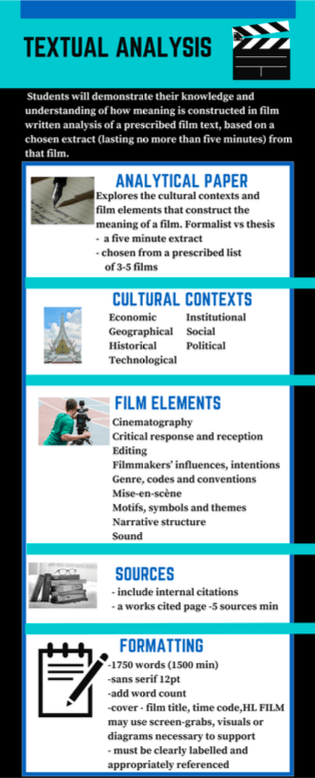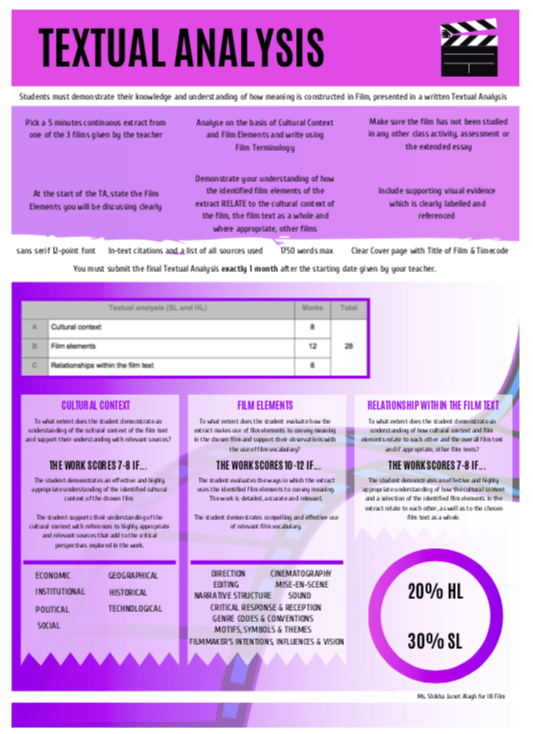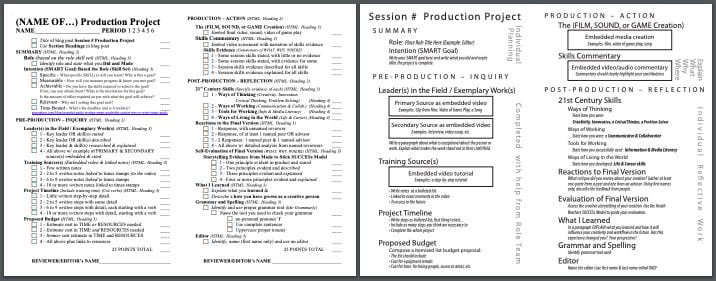TASK COMPONENTS (INQUIRY)
|
NOTES
WRITE NOTES IN THIS COLUMN |
| The extract may be up to five minutes in length and must be a single, continuous sequence of the film |
|
| Time of 5-minute clip |
PLACE 5-MINUTE TIME INTERVAL HERE… |
PART 1 – The film, your scene, why it is of interest, and how your scene relates to the whole film.
|
|
Brief Summary of Exposition
Writer, Director, Producer, studio, year released Main characters, conflict, identify the genre. Identify the aspect ratio. |
|
Context of Extract in Film – briefly describe the scene
At what times does your scene occur, how it begins, and how it ends. Do not describe it further. The judges have seen the movie. |
|
The Rationale for Selection – relation to the entire movie
Why is it interesting and why does this scene best illustrate the themes of the whole movie? |
|
PART 2 – Remember to integrate the Director’s intent with each of the following areas in this section
|
|
Narrative
|
|
| Script – Not just dialogue but in terms of being the spine of the story
Explain how this scene advances the plot. How do the events of this scene clarify/complicate matters? How does this scene affect/cause future events? What new information is revealed or suggested about a character? Is there anything deliberately withheld? Is anything unusual in the dialogue? Word choice? Delivery? Accents? Repetition? |
|
Cinema Photography
|
|
| a) Camerawork – describe shots in specific terms
Shot size: ELS, LS (stage), full shot, MS, CU, ECU. Camera angles: bird’s eye, high angle, eye level, low angle or Dutch (oblique), camera movement: pan, tilt, dolly or tracking, handheld, Steadycam, or moving crane. Invisible V conspicuous. Are tracking shots motivated by character movement? |
|
| b) Composition
Open/closed composition, aspect ratio, rule of thirds, Kubrick single-point perspective. |
|
| c) Depth of Field
Consider foreground, mid, ground, and background. Deep focus is associated with wide-angle lenses. Could be flat. Narrow ranges of focus may be the result of telephoto lenses. |
|
Mise-en-scene – The overall look and feel of a movie
|
|
| a) Position of characters and objects
Identify the dominant, does movement guide our focus, character proxemics patterns (intimate, personal, social, and public distances). How does the director add meaning to these choices? Is one character encroaching on another’s space? Watch for space being used to portray relationships/changes in relationships. Watch for windows, doors, and parallel lines that frame people or objects. Entrapment. Look for actor placement. Front – actor facing camera, greatest intimacy. One-Quarter Turn – very popular. Profile – character lost in the moment, a bit more distant than the previous two. Three-Quarters Turn – useful to convey anti, socialness, Back of Head, most anonymous shot. Creates a mystery or feeling of alienation. |
|
| b) Lighting
Low or high key. How does the director use light to focus our attention? The Key light, fill light, and backlighting. What is the source of lighting in the context of the scene? |
|
| c) Color scheme
How does the director use color and what is the director’s intent for doing so? Look for color symbolism or color associated with characters. Color to suggest a mood. Color as foreshadowing. Contrasting colors ( the monolith v white room) |
|
| d) Set/location/props
Set design. Studio or on, location, describe props, scenery, what was the Director ́s intent for using them? How dense is visual information? Stark, moderate, or highly detailed? |
|
| e) Costume, hair, make up
Period, class, gender (emphasize or diminish), age-appropriate, silhouette (close-fitting or baggy), fabric (plain, sheer, rough, delicate), accessories. Color is very important in relation to character. |
|
| f) Acting/body language
Acting style, body language, blocking, period, or contemporary. Individualized (Joker), Stylization. Look for subtext (the character says one thing but means something else). Consider typecasting as a shortcut to characterization. |
|
Sound – watch scene w/o picture
Live sound, sound effects, and music. Sound can be diegetic, meaning characters would hear it, or non, diegetic, meaning that characters would not hear it, such as narration or music over the credits. Explore the relationship between diegetic and non, diegetic sound when appropriate. |
|
Music
Is the music telling you what to feel? Music can be used as a counterpoint to the action. |
|
Editing
Ellipsis (time compression) and cross-cutting, fades, dissolves (fades between scenes), wipes, matching cuts, straight cuts, dialogue overlap, and sound bridges. Consider how long each shot lasts. |
|
Part 3: Analyzing the Film as a Product
|
|
|
In what way was this movie a product of its time? What does the audience learn about the culture or historical context of the film? |
|
Target Audience
Teens/adults or male/female age group, college education art crowd, liberal, conservative, Christian |
|
Generic Expectations
http://www.filmsite.org/filmgenres.html Also research http://tvtropes.org/pmwiki/pmwiki.php/Main/Tropes |
|
Themes
Man V Man, or one of the others, is this film an allegory? |
|
Motifs/Symbols
What specific devices support your definition of the theme? Look for recurring elements. |
|
Film Criticism
Both contemporary and current. Use brief quotes from two different sources. Record the details: reviewers’ names and publication names/dates |
|
TASK COMPONENTS (ACTION)
|
|
| Compose Paper |
|
Part 4: Sources
|
|
| Source 1 |
|
| Source 2 |
|
| Source 3 |
|
| Source 4 |
|
| Source 5 |
|
| Source 6 |
|
| Source 7 |
|
| Source 8 |
|
| Source 9 |
|
| Source 10 |
|
TASK COMPONENTS (REFLECTION)
|
|
| Revision 1 |
Proofreader: |
| Revision 2 |
Proofreader: |
| Revision 3 |
Mr. Le Duc |




